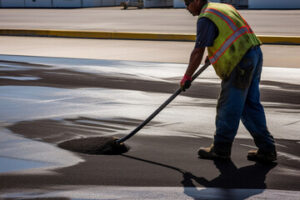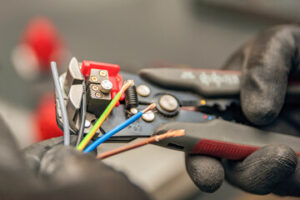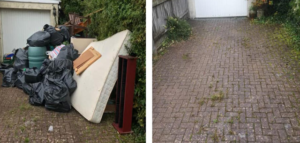Rodents are a threat because they gnaw on things, causing damage and creating fire hazards. They breed quickly and multiply to dangerous levels.
The best way to keep rodents away is by removing food, shelter and entry points. Look for feces, rub marks and chewed openings indoors and outdoors, including smear marks on the floor and baseboards. Peppermint oil and ultrasonic repellents can be used to deter rodents without using traps or chemicals. Contact Rodent Removal Texas now!

Rodents are opportunistic pests that will enter your home looking for food, water and shelter. They can cause major damage to structures, electrical systems and plumbing, while also posing health risks to humans. Once inside, rodents can gnaw through wires and insulation. They can also spread bacteria and viruses. Several diseases are transmissible to people through direct contact with rodent droppings and nesting materials, by being bitten or scratched by fleas or mites that have fed on infected mice and rats, and by eating contaminated food.
The best way to avoid rodent infestation is prevention. Start by inspecting your property. Look for rodent entrance points in the eaves, around chimney openings and in the foundation walls. Check for gnawed wood, dusty rodent tracks, droppings and other signs of activity. Also look for scurrying sounds in attics, basements and crawl spaces.
Make your home as inaccessible to rodents as possible by removing potential nesting sites. Store pet food, garbage and compost waste in sealed containers; clean up leaf piles, twigs and brush around the house and on the property. Keep outdoor trash cans tightly closed, and regularly remove them to prevent attracting rodents.
Historic and older homes often feature small gaps, cracks and crevices that can give rodents easy entry. If your home has these features, consider hiring a professional to repair them before you experience a rodent infestation.
In addition to fixing any damaged areas of your home, you can take steps to deter rodents from entering. Start by walking around your upstate New York home looking for potential entry points. Look for holes in the soffits, foundation or drywall; watch out for cracks under doors and windows; and examine where pipes or wires pass through drywall. Look for rodent droppings (small rice size is a mouse, almond size is a rat); and for any signs of gnawed wood, wire or insulation.
Eliminate moisture sites on your property by sealing all cracks and holes on the outside of your upstate NY home, including those where utilities enter; use caulk or steel wool to do this. Install door sweeps on exterior doors; repair any broken screens; and screen vents and chimney openings. In addition, remove any shrubs or trees too close to your home, as rodents can hide under them and crawl through open windows to gain access. Also, store items such as woodpiles and gardening tools in plastic containers rather than cardboard boxes to discourage rodents. Regularly sanitize kitchen counters and floors, and be sure to clean up spills, crumbs and uncovered foods immediately. Finally, be sure to wear gloves when handling dead rodents or resetting traps and cleaning or disinfecting items contaminated by them. After handling or resetting traps, thoroughly wash your hands using a general household disinfectant or phenol-containing soap.
Detection
Rodents are more than just a nuisance; they cause serious health, safety and property damage. They spread disease, chew through wiring and other materials, contaminate food supplies, and create fire hazards. They also destroy buildings and other structures, often resulting in costly repairs. Rodents are prolific breeders, and one rodent in a home or business can lead to a serious infestation that requires professional removal services.
Early detection of rodents is critical to the effectiveness of pest control programs. Fortunately, there are many early warning signs to look for, including droppings, tracks and rub marks.
Droppings
Rodents typically track in dirt and dust when moving through an area, leaving a trail behind them. If you find rodent droppings in and around your kitchen, pantry or drawers, it’s time to call a pest professional for a home inspection.
Tracks
Rats have five toes on their hind feet and four toes on their front feet, and they typically leave the same tracks everywhere they go. You can detect these runways by lightly dusting the suspected area with flour or baby powder, then shining a flashlight or blacklight over it. You can also use a damp sponge to wipe the dirt off a wall and see if you can find smudge marks or footprints.
Gnaw marks
Since rats and mice have continuously growing paired incisor teeth, they must constantly gnaw on hard surfaces to keep them short and manageable. This behavior can damage woodwork, wires, drywall and insulation. In addition, gnawing may create holes that allow entry points for rodents. Look for gnaw marks on your furniture, boxes in your pantry, food containers and walls.
Nesting materials
Mice and rats build their nests with shredded paper products, cotton, packing materials and wall insulation, along with other available items. They can also leave smudge marks on walls and floors that are caused by their oily fur as they rub against surfaces to mark their pathways.
Rodents are most active at night, and scurrying sounds in the ceiling or walls can indicate their presence. They are also known to burrow into walls and other areas, so listen for scratching or gnawing in attics or crawl spaces.
Look for gnawed or chewed wires, discarded food debris and stale smells in and around your house. Clean up trash and compost piles regularly, and store foods in sealed containers. Inspect for gaps and cracks outside that may be used as points of entry, and seal these with caulking or copper mesh. Make sure your yard is free of potential rodent nesting sites such as leaf piles and deep mulch. A thorough inspection of your house, garage, attic, basement and foundation can help you determine the best rodent removal methods. Depending on the extent of your infestation, these may include traps, baits or repellents.
Treatment
Rodents may look cute in cartoons, but they are dangerous pests in real life. They cause property damage by chewing through wires, insulation, and wood. They also contaminate food supplies with their urine, feces, and fur. In commercial settings, rodent infestations can lead to costly downtime and loss of reputation. In addition, they can pose a health risk and trigger allergies and asthma in humans. For these reasons, prevention is essential.
A few basic steps can help deter rodents from entering homes and buildings. Sealing entry points is one of the most effective control measures. Use caulk or expanding foam to close cracks and gaps around the foundation, doors, and windows. Be sure to seal shut any openings where utility lines enter the home. Keep weeds, grass, and shrubs away from structures to prevent rodents from using them as shelter or nesting areas.
An important part of prevention is eliminating sources of food and water for rodents. Store foods in airtight containers and keep garbage bins with tight-fitting lids. Regularly clean kitchens and dining areas to eliminate crumbs and spills that can attract rodents. Keep basements, attics, and garages clean to reduce places for rodents to hide. Consider natural repellents such as peppermint oil, mothballs, and cloves as an additional preventive measure.
If you see signs of rodents in your home, take action immediately. Leaving the problem unaddressed can lead to increased damage and severe structural problems. The best course of action is to call your local Orkin branch for a professional inspection and customized solution.
The cost of rodent removal varies depending on the size and extent of the infestation, the type of trap used, and property characteristics. For example, eradicating rodents from hard-to-reach locations such as wall voids or attics typically requires more extensive work and higher costs than removing them from an open-access garage or shed. Geographical factors also influence price. The cost of rodent removal is generally cheaper in areas with lower rates of pest prevalence and competition.
Keeping rodents at bay can be difficult, but a few simple preventive measures can go a long way. Remove piles of debris or clutter from your yard, and keep trees and bushes 3 feet away from buildings to prevent rodents from using them as hiding spots or shelter.
Integrated pest management (IPM) involves a combination of control methods designed to reduce the occurrence and severity of rodent infestations. Your Orkin Pro can design an IPM plan specific to your needs that includes both non-chemical and chemical control measures. Follow-up visits help ensure that the plan is working and identify any new concerns. For the most effective results, preventative strategies should be implemented year-round. A well-implemented IPM program can greatly reduce the need for more extensive, expensive rodent control measures in the future.








